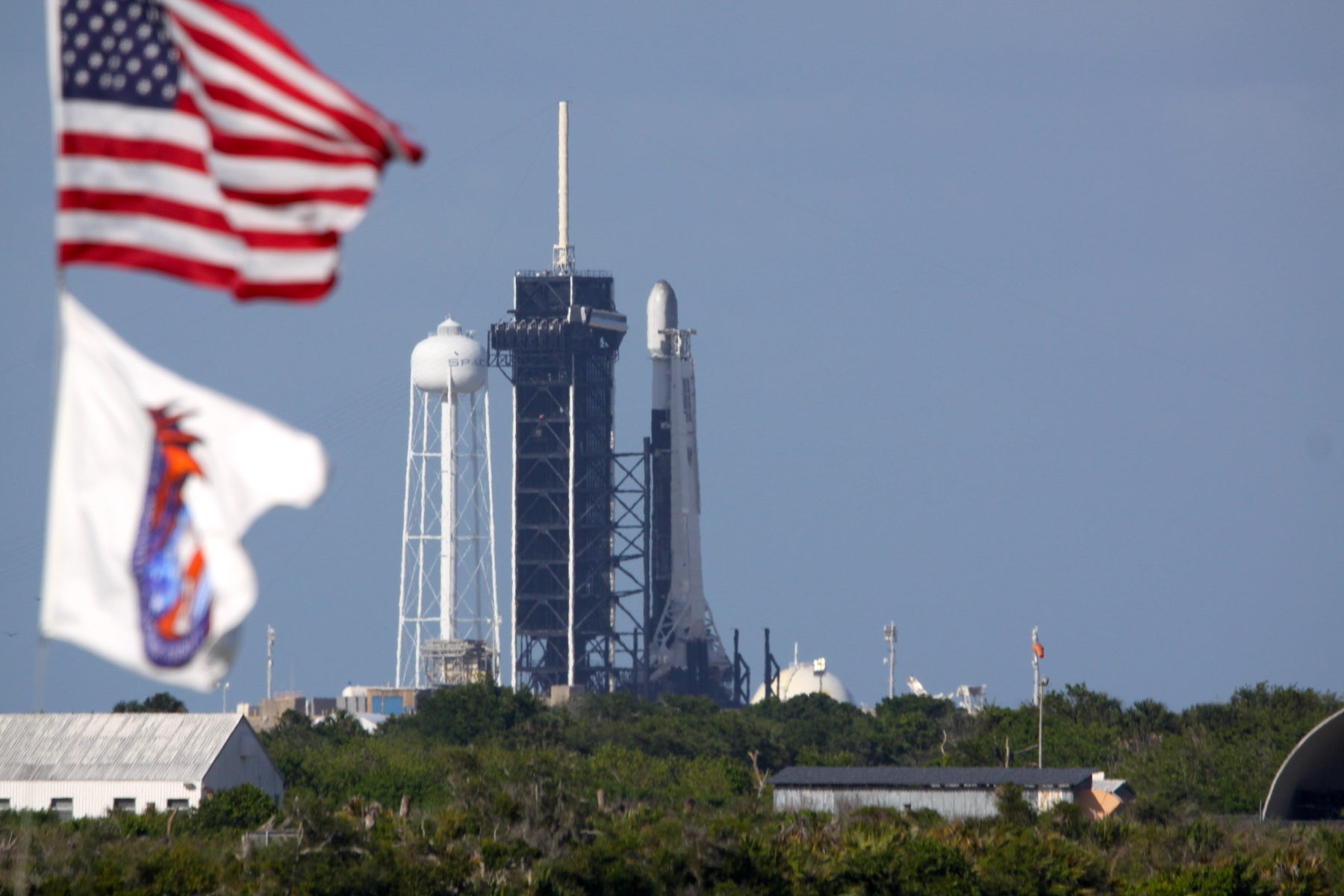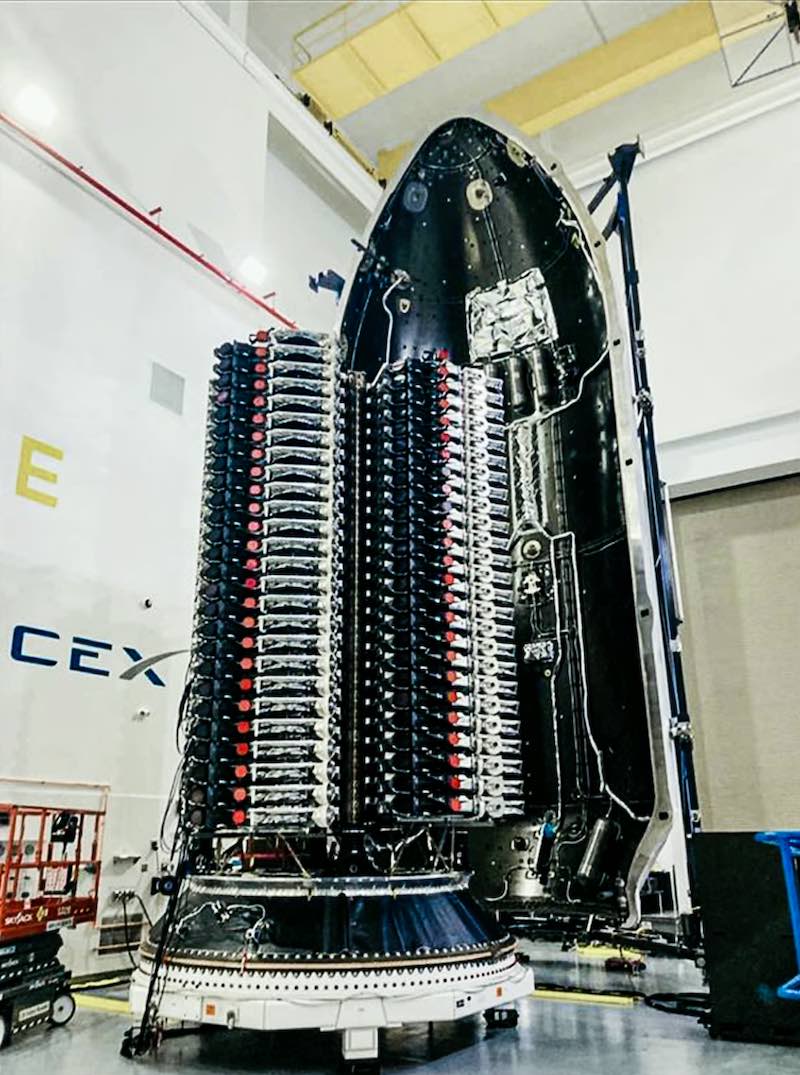Space News & Blog Articles
Cape Canaveral’s busy January to continue with another Starlink launch
 File photo of a Faclcon 9 rocket on pad 39A at NASA’s Kennedy Space Center. Credit: Stephen Clark/Spaceflight Now
File photo of a Faclcon 9 rocket on pad 39A at NASA’s Kennedy Space Center. Credit: Stephen Clark/Spaceflight Now
Forecasters expect brisk winds and chilly temperatures for a prime time, full moon launch of a SpaceX Falcon 9 rocket with another batch of Starlink internet satellites Monday night from NASA’s Kennedy Space Center in Florida.
There’s a 70 percent chance of good conditions for launch at 7:26 p.m. EST Monday (0026 GMT), according to a forecast issued Saturday morning by the U.S. Space Force’s 45th Weather Squadron. There’s a backup instantaneous launch opportunity at 9:24 p.m. EST (0224 GMT).
The mission, designated Starlink 4-6, will carry around 49 Starlink internet satellites into orbit for SpaceX’s global internet network. The Falcon 9 is expected to fly southeast from pad 39A at Kennedy Space Center, heading over the Atlantic Ocean just north of the Bahamas before making a slight right-hand turn to line up with the target orbital plane for deployment of the Starlink payloads.
The flight profile is expected to match that of the most recent Starlink launch Jan. 6, which was the first Starlink mission from Florida to head southeast, rather than northeast. That mission carried 49 flat-panel Starlink satellites into space. SpaceX hasn’t announced yet how many Starlink satellites are on Monday’s launch, but it’s expected to be a similar number.
Launch trajectories from Cape Canaveral have historically tracked east or northeast over the Atlantic Ocean.
But SpaceX, with approval from the Space Force’s Eastern Range, has opened new launch trajectories in recent years. Falcon 9 missions have also flown south along the Florida coastline to reach polar orbit, a destination that was inaccessible from Cape Canaveral for 50 years.
U.S. launches into polar orbit have typically departed from Vandenberg Space Force Base in California, which has an open range of ocean to the south of the spaceport.
The south and southeast launch paths from Cape Canaveral require rockets to perform turns, or “dog-leg” maneuvers, using some of their performance to fly around land masses and populated areas. That reduces the number of Starlink satellites SpaceX can launch on a single mission, but the company has said it intends to use the southeast launch trajectories in winter months to improve the chances of good offshore conditions for landing of the Falcon 9’s first stage booster.
For this mission, like the last Starlink launch, SpaceX’s drone ship will be parked north of the Abacos Islands in the Bahamas. For launches to the northeast, the landing platform is positioned east of Charleston, South Carolina, a region that sees rougher seas and higher winds in the winter.
 A stack of Starlink satellites awaiting encapsulation inside the payload fairing before a previous Falcon 9 launch. Credit: SpaceX
A stack of Starlink satellites awaiting encapsulation inside the payload fairing before a previous Falcon 9 launch. Credit: SpaceX
SpaceX will surpass the 2,000-satellite mark in its Starlink program with Monday night’s launch. Roughly 200 of those satellites have failed or been decommissioned by SpaceX’s ground control team, according to a tabulation maintained by Jonathan McDowell, an astrophysicist and respected tracker of global spaceflight activity.
The Starlink 4-6 mission will be SpaceX’s 35th dedicated launch since May 2019 for the Starlink program.
SpaceX has a long-term plan to launch as many as 42,000 Starlink satellites, according to a company filing with the International Telecommunication Union. The company’s initial focus is on deploying thousands of satellites into five orbital “shells.”
The 53.2-degree inclination shell, the target for Monday night’s launch is one of the five orbital shells at different inclination angles that SpaceX plans to fill with around 4,400 satellites to provide high-speed, low-latency broadband connectivity around the world. The first shell, at 53.0 degrees, was filled with its full complement of satellites last May.
As of last week, SpaceX said the Starlink network is now live in 25 countries and regions, serving more than 145,000 users worldwide. SpaceX builds its Starlink satellites on an assembly line in Redmond, Washington, and the company is developing and iterating its own user terminals.
SpaceX hopes to use revenue from the Starlink business unit to help fund the company’s ambitions to complete development of the heavy-lift Starship rocket, a massive fully reusable launcher designed to eventually replace the Falcon 9 and Falcon Heavy rockets.
On Monday night’s mission, the Falcon 9 rocket is expected to target an orbit a couple hundred miles above Earth. After flying free of the launch vehicle, the 49 Starlink satellites — each about a quarter-ton in mass — will unfurl solar panels and use ion thrusters to climb to an operational altitude of 335 miles (540 kilometers).
The forecast for Monday night calls for a mostly clear sky and gusty west winds of 20 to 25 mph. The temperature at launch times is forecast to be around 52 degrees Fahrenheit.
Rainy weather is expected along the Space Coast Sunday, but the weather system will push through the region in time for Monday evening’s launch opportunity, according to the Space Force weather team.
“Clouds will diminish through the day Monday at the spaceport, leaving gusty winds as the primary launch weather threat,” the forecaster team wrote. “On Tuesday, high pressure will settle overhead making for a chilly morning, but excellent launch weather conditions.”
The launch will continue a busy January at the Florida spaceport, with seven rocket launches scheduled on the Eastern Range. Two of the missions, both by SpaceX, are already in the books, with five more on tap before the end of the month, including Monday’s Falcon 9 flight.
A small satellite launcher developed by Astra is slated to take off as soon as next week from the Complex 46 launch pad at Cape Canaveral, carrying several CubeSats into orbit on a demonstration flight for NASA.
United Launch Alliance’s first mission of 2022 is scheduled for Friday, Jan. 21, with a pair of Space Force surveillance satellites heading to geostationary orbit.
Two more SpaceX launches are scheduled for the last week of January from each of the company’s Florida launch pads.
This email address is being protected from spambots. You need JavaScript enabled to view it. the author.
Follow Stephen Clark on Twitter: @StephenClark1.
When you subscribe to the SpaceZE News Feed, we will send you an e-mail when there are new updates on the site so you wouldn't miss them.

